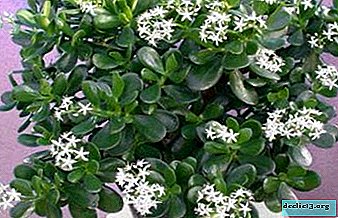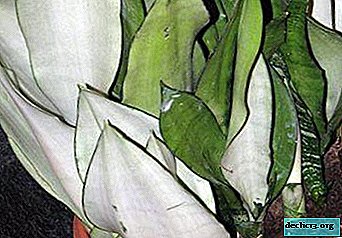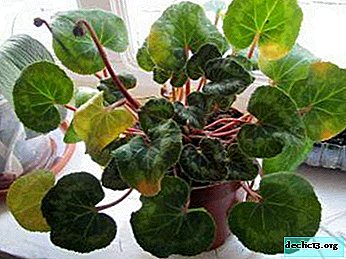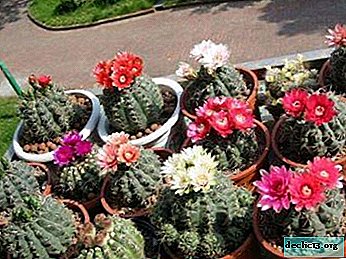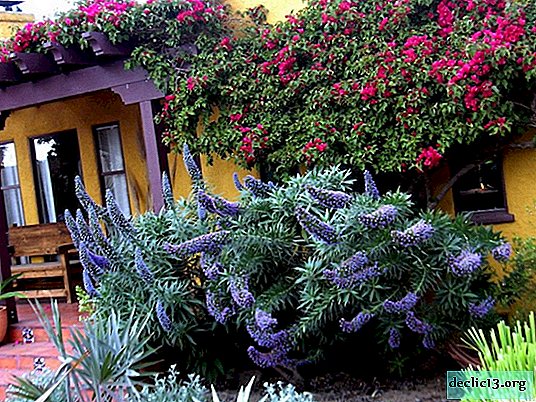How to understand when pomegranate ripens, and why does it not always bear fruit?

Pomegranate can be grown not only in the garden, but also at home. Moreover, they are grown not only for decorative purposes, namely to obtain tasty and healthy fruits. However, this is a rather troublesome task.
But it is important to know the features of harvesting and storage of crops, so that the fruiting plant does not lose its appearance and taste. This article describes in detail how to understand when a pomegranate ripens and why it does not always bear fruit.
Features of fruiting
Fruiting tree begins at 3 years of age. It lasts for 5-35 years. Pomegranate belongs to early crops. Its first fruits can be removed in the 2nd year after planting.
When the crop is harvested, the shoots on which there were pomegranates begin to dry out.The fruit ripening period depends on the plant propagation method:
- If seeds were used for this, then the tree gives fruit already for 3-4 years of life.
- If propagation occurred by cuttings, then the tree can bear fruit already in the 2nd year.
This phenomenon is due to the fact that for rooting and growing a plant from an already prepared lignified shoot, less time is required than for a bush grown from seeds.
How to understand that the crop can be harvested?
And although fruits can be harvested already in mid-October, sometimes their palatability at this time is bad. To avoid such problems, you need to know some recommendations:
- The fruit grains should have an oblong shape and a ribbed surface. Unripe grains have a round shape.
- The skin color should be bright. There may be the fruits of pink and burgundy edema. Pallor indicates the presence of acid.
- The skin should be whole, dry and thin. If there are cracks on it, then the berry is overripe.
- There should be a loud metallic sound during tapping. The green fruit has a dull sound.
- Ripe fruit does not emit aroma. But the unripe pomegranate smells strongly.
- When the pomegranate ripens, it becomes resilient. The softness and the presence of spots on the peel indicates a rotting process.
- Ripe fruit only seems light in appearance; its weight directly depends on the size of juicy grains. Heavy pomegranate is very juicy, and unripe - light.
- You can determine the ripeness of the fruit by inflorescence. The flower should be dry, ripe and without any greens.
Varietal features of ripening
There are about 350 varieties of pomegranate., when growing most of which you can collect tasty and healthy fruits that can both be stored for a long time and well transported. From the whole variety, several varieties can be distinguished.
Krimyzy-Kabuh

Ripe fruits are large 350-400 g, bright red in color and have a spherical shape. The fruits ripen in mid-October.
Gulosh azerbaijani

Ripe fruits weigh 300-400 grams. The peel of a ripe pomegranate is pinkish-red in color, thin and shiny, and in green it is light pink. Ripen by mid-October.
Nazik Kabuh

Ripe fruit weighs 400 g and has a deep red color. The crust is thin, and the grains are large. The fruits ripen in early or mid-October.
Achik Dona

Ripe fruits are large, spherical in shape. The skin of the fruit is yellowish pink, and the unripe fruit is light brown. The fruits ripen in early or mid-October.
Plant care during fruit ripening
In order for the pomegranate to bear fruit well and give a quality crop, it is necessary to properly care for it:
- Watering. The tree must be moistened under the root so that the liquid does not penetrate the leaves. For these purposes, use a watering can with a narrow nose.The soil should always be slightly moist. It is necessary to use water at room temperature and settled for irrigation.
- Top dressing. Since the fruits will be eaten, for fertilizers it is better to use not mineral compounds that contain nitrates, but organic ones - slurry, chicken manure solution.
How to pick fruit?
The process of collecting pomegranate fruits has its own characteristics:
- To take unripened fruits from the bushes is necessary only in case of bad weather.
- Ripe fruits are removed from the branches before their peels crack.
Why are no fruits formed on the plant and what to do?
Natural causes
The absence of fruiting can be observed when not all pomegranate flowers can bear fruit, since this is a cross-pollinated crop.
There are two types of flowers on the pomegranate:
- with a short pestle - does not form fruits;
- with a long pestle - fruits are tied.
It is in 95% that barren flowers are observed.
Unnatural reasons
 Pomegranate fruiting may not occur for the following unnatural reasons:
Pomegranate fruiting may not occur for the following unnatural reasons:
- Lack of heat. Pomegranate needs a warm climate.
- Lack of light. A tree or bush should be grown only in a well-lit place. In the shade it will bloom poorly and produce few fruits.
- Bad soil. Pomegranate must be grown on loose soil with a neutral pH.
- For a tree to begin to bloom, it must be grafted onto another.
- It is not necessary to water the plant often, since because of this it will hurt, and the fruits will not appear.
How to store the crop?
The storage process of the harvest should be as follows:
- It is necessary to sort out the grenades, remove the damaged ones. Do not wash them, but wrap each fruit with parchment.
- For storage, you can use the refrigerator, or rather the fruit box, which is located at the bottom. It must be washed with baking soda, wait for the excess glass liquid.
- Spread the fruits in rows, you can put them on top of each other.
- Place a sheet of paper on top, set the box in the refrigerator, and the temperature should be 0-4 degrees.
- Subject to all conditions, the crop will be stored for 2-3 months.Once a week, you need to perform an audit, change the fruits in places and remove the damaged ones.
- If there is a basement, then you can put the paper-wrapped fruits on the shelves. It is best to do this in a row so that the grenades do not touch each other.
Growing pomegranates is a troublesome business, but the process of collecting and storing the crop is less responsible. Only compliance with all the above conditions will allow you to collect ripe and high-quality fruits that will be stored for a long time.




